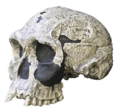Like contemporary Homo, H. habilis brain size generally varied from 500–900 cm3 (31–55 cu in). The body proportions of H. habilis are only known from...
50 KB (6,128 words) - 03:47, 28 May 2024
include Homo erectus and Homo neanderthalensis. The oldest member of the genus is Homo habilis, with records of just over 2 million years ago. Homo, together...
91 KB (7,878 words) - 05:20, 2 June 2024
Homo, though they both agreed that the remains could belong to habilis. KNM-ER 1470 was much larger than the Olduvai remains, so the terms H. habilis...
32 KB (3,893 words) - 01:43, 14 November 2023
between Stw 53 and H. habilis by Curnoe was that some of the tooth crowns of Stw 53 were larger than the average tooth crowns of H. habilis whereas other tooth...
14 KB (1,582 words) - 04:03, 22 May 2024
Human evolution (redirect from Evolution of Homo sapiens)
Kenya. The earliest member of the genus Homo is Homo habilis which evolved around 2.8 million years ago. H. habilis is the first species for which we have...
253 KB (26,320 words) - 13:31, 29 May 2024
appearance of genus Homo takes place around 2.8 million years ago with Homo habilis, followed by Homo erectus at around 1.8 million years ago, Homo neanderthalensis...
39 KB (5,203 words) - 21:53, 20 May 2024
Human taxonomy (redirect from Homo sapiens sapiens)
species of Homo (alongside H. habilis and H. erectus) at about 2 million years ago, or alternatively as transitional between Australopithecus and Homo. Wood...
34 KB (5,073 words) - 15:14, 25 April 2024
Neanderthal (redirect from Homo sapiens neanderthalensis)
Neanderthals (/niˈændərˌtɑːl, neɪ-, -ˌθɑːl/ nee-AN-də(r)-TAHL, nay-, -THAHL; Homo neanderthalensis or H. sapiens neanderthalensis) are an extinct group of...
329 KB (35,789 words) - 05:20, 31 May 2024
Human (redirect from HomoSapiens)
specimen LD 350-1 from Ethiopia, and the earliest named species are Homo habilis and Homo rudolfensis which evolved by 2.3 million years ago. H. erectus (the...
264 KB (25,023 words) - 07:17, 27 May 2024
Homo luzonensis, also known as Callao Man and locally called "Ubag" after a mythical caveman, is an extinct, possibly pygmy, species of archaic human from...
15 KB (1,683 words) - 07:01, 25 May 2024
australopithecines as well as earlier and more basal species of Homo, such as H. habilis. Among these features are their larger body mass, relatively long...
72 KB (9,273 words) - 19:18, 22 May 2024
species to either H. habilis or to a minimally habilis-erectus-ergaster-sapiens clade, and its line much more ancient than Homo erectus itself. Argue...
136 KB (15,777 words) - 21:24, 19 May 2024
off very early from contemporaneous Homo. It is unclear whether they branched off at around the time of H. habilis, H. rudolfensis, and A. sediba, are...
45 KB (5,094 words) - 00:05, 2 June 2024
Timeline of human evolution (section Homo)
the major events in the evolutionary lineage of the modern human species, Homo sapiens, throughout the history of life, beginning some 4 billion years ago...
87 KB (3,515 words) - 00:18, 2 June 2024
Denisovan (redirect from Homo Denisovan)
archaic humans. The third molar is outside the range of any Homo species except H. habilis and H. rudolfensis, and is more like those of australopithecines...
68 KB (7,083 words) - 22:25, 29 April 2024
Early modern human (redirect from Anatomically modern Homo sapiens)
(EMH), or anatomically modern human (AMH), are terms used to distinguish Homo sapiens (the only extant Hominina species) that are anatomically consistent...
114 KB (12,460 words) - 15:25, 26 April 2024
However, in conjunction with dental evolution, it is expected that Homo habilis would display smaller teeth than those of the hominids before them. Furthermore...
19 KB (2,011 words) - 15:07, 15 May 2024
same (presumably australopithecine) ancestor as H. habilis, making it a sister taxon to H. habilis. H. floresiensis would thus represent a hitherto unknown...
64 KB (6,982 words) - 03:53, 29 May 2024
paniscus Homo habilis Homo rudolfensis Homo ergaster Homo erectus Homo antecessor Homo heidelbergensis Homo naledi Homo neanderthalensis Homo denisova Homo sapiens...
23 KB (2,391 words) - 16:15, 23 May 2024
and fossils of Paranthropus boisei and Homo habilis, as does Bed II, 1.7 to 1.2 mya. H. habilis gave way to Homo erectus at about 1.6 mya, but P. boisei...
30 KB (3,714 words) - 05:47, 2 May 2024
Homo heidelbergensis (also H. erectus heidelbergensis, H. sapiens heidelbergensis) is an extinct species or subspecies of archaic human which existed during...
69 KB (8,374 words) - 04:34, 23 May 2024
uncovering further evidence for australopithecines, as well as for Homo habilis and Homo erectus. The scientific community took 20 more years to widely accept...
47 KB (5,028 words) - 21:23, 31 May 2024
Paleolithic (section Homo erectus)
Humankind gradually evolved from early members of the genus Homo—such as Homo habilis, who used simple stone tools—into anatomically modern humans as...
107 KB (11,377 words) - 22:09, 31 May 2024
Early expansions of hominins out of Africa (redirect from Dispersal of Homo erectus)
be considered Homo habilis, or a form of early Homo or late Australopithecus closely related to Homo habilis, or a very early form of Homo erectus. In any...
55 KB (6,048 words) - 04:40, 22 May 2024
SK 847 (category Homo habilis fossils)
847 is the abbreviated designation for the fossilized fragments of a Homo habilis cranium, discovered in South Africa, which was dated to an age between...
6 KB (713 words) - 22:41, 9 March 2022
Australopithecine (section Relation to Homo)
extinct, close relatives of modern humans and, together with the extant genus Homo, comprise the human clade. Members of the human clade, i.e. the Hominini...
17 KB (1,549 words) - 10:36, 5 May 2024
derived from the more primitive Oldowan technology associated with Homo habilis. The Acheulean includes at least the early part of the Middle Paleolithic...
42 KB (4,899 words) - 22:14, 31 May 2024
Evolution of human intelligence (section Homo)
evolution (see Homininae), starting from about 600 cm3 in Homo habilis up to 1500 cm3 in Homo neanderthalensis. Thus, in general there's a positive correlation...
107 KB (12,467 words) - 10:27, 4 May 2024
Homo longi is an extinct species of archaic human identified from a nearly complete skull, nicknamed 'Dragon Man', from Harbin on the Northeast China Plain...
19 KB (2,163 words) - 15:11, 1 June 2024
evolved (see Homininae), starting from about 600 cm3 in Homo habilis up to 1680 cm3 in Homo neanderthalensis, which was the hominid with the biggest...
52 KB (6,029 words) - 18:56, 1 April 2024

























